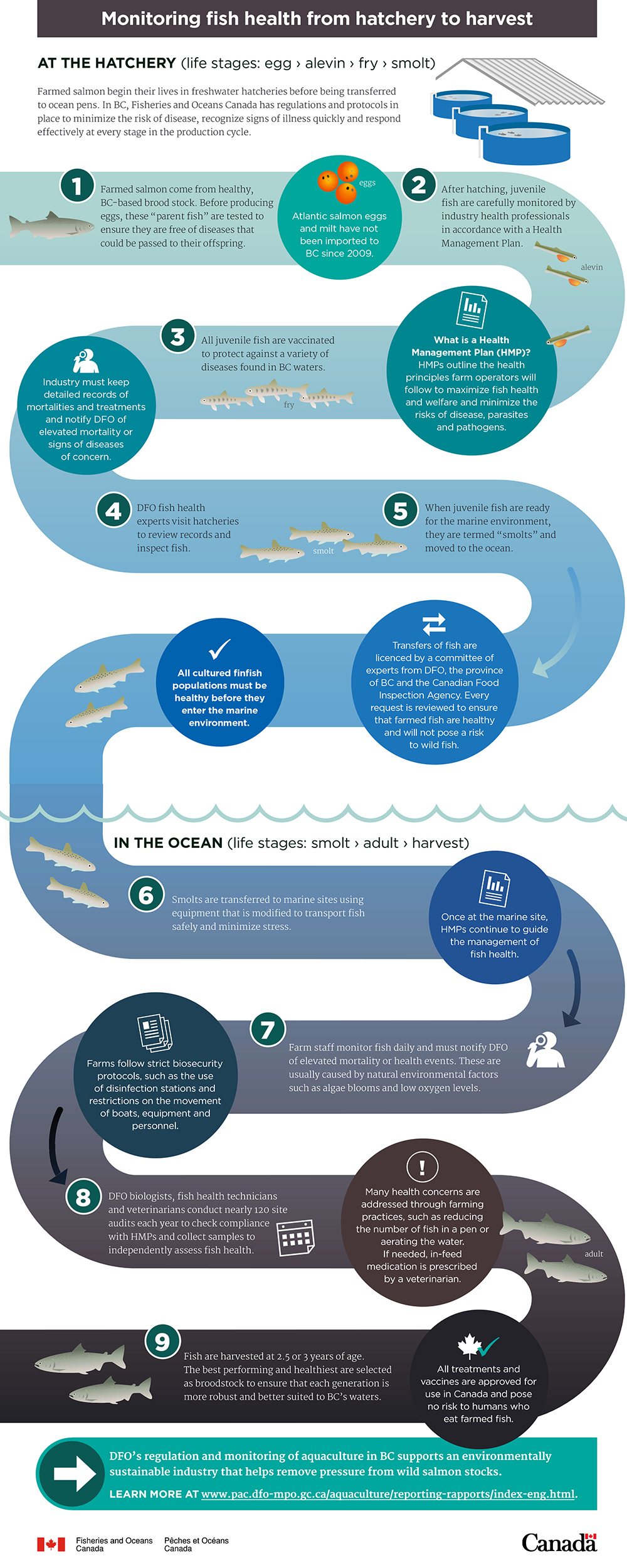Monitoring fish health from hatchery to harvest
Release date: January 2019

Description: Monitoring fish health from hatchery to harvest
At the hatchery (Life stages: egg, alevin, fry, smolt)
Farmed salmon begin their lives in freshwater hatcheries before being transferred to ocean pens. In BC, Fisheries and Oceans Canada has regulations and protocols in place to minimize the risk of disease, recognize signs of illness quickly and respond effectively at every stage in the production cycle.
| At the hatchery | Information |
|---|---|
| 1. Farmed salmon come from healthy, BC-based brood stock. Before producing eggs, these “parent fish” are tested to ensure they are free of diseases that could be passed to their offspring. | Atlantic salmon eggs and milt have not been imported to BC since 2009. |
| 2. After hatching, juvenile fish are carefully monitored by industry health professionals in accordance with a Health Management Plan. | What is a Health Management Plan (HMP)? HMPs outline the health principles farm operators will follow to maximize fish health and welfare and minimize the risks of disease, parasites and pathogens. |
| 3. All juvenile fish are vaccinated to protect against a variety of diseases found in BC waters. | Industry must keep detailed records of mortalities and treatments and notify DFO of elevated mortality or signs of any diseases of concern. |
| 4. DFO fish health experts visit hatcheries to review records and inspect fish. | n/a |
| 5. When juvenile fish are ready for the marine environment, they are termed “smolts” and moved to the ocean. | Transfers of fish are licenced by a committee of experts from DFO, the province of BC and the Canadian Food Inspection Agency. Every request is reviewed to ensure that farmed fish are healthy and will not pose a risk to wild fish. All cultured finfish populations must be healthy before they enter the marine environment. |
In the ocean (life stages: smolt—adult—harvest)
| In the ocean | Information |
|---|---|
| 6. Smolts are transferred to marine sites using equipment that is modified to transport fish safely and minimize stress. | Once at the marine site, HMPs continue to guide the management of fish health. |
| 7. Farm staff monitor fish daily and must notify DFO of elevated mortality or health events. These are usually caused by natural environmental factors such as algae blooms and low oxygen levels. | Farms follow strict biosecurity protocols, such as the use of disinfection stations and restrictions on the movement of boats, equipment and personnel. |
| 8. DFO biologists, fish health technicians and veterinarians conduct nearly 120 site audits each year to check compliance with HMPs and collect samples to independently assess fish health. | Many health concerns are addressed through farming practices, such as reducing the number of fish in a pen or aerating the water. If needed, in-feed medication is prescribed by a veterinarian. All treatments and vaccines are approved for use in Canada and pose no risk to humans who eat farmed fish. |
| 9. Fish are harvested at 2.5 or 3 years of age. The best performing and healthiest are selected as broodstock to ensure that each generation is more robust and better suited to BC's waters. | n/a |
DFO's regulation and monitoring of aquaculture in BC supports an environmentally sustainable industry that helps remove pressure from wild fish stocks.
- Date modified: